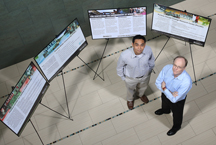Drop in global malnutrition depends on ag productivity, climate change
May 29, 2014
 |
|
Agricultural economists Uris Baldos, left, and Thomas Hertel. |
WEST LAFAYETTE, Ind. - Global malnutrition could fall 84 percent by the year 2050 as incomes in developing countries grow - but only if agricultural productivity continues to improve and climate change does not severely damage agriculture, Purdue University researchers say.
"The prevalence and severity of global malnutrition could drop significantly by 2050, particularly in the poorest regions of the world," said Thomas Hertel, Distinguished Professor of Agricultural Economics. "But if productivity does not grow, global malnutrition will worsen even if incomes increase. Climate change also adds a good deal of uncertainty to these projections."
Hertel and doctoral student Uris Baldos developed a combination of economic models - one that captures the main drivers of crop supply and demand and another that assesses food security based on caloric consumption - to predict how global food security from 2006 to 2050 could be affected by changes in population, income, bioenergy, agricultural productivity and climate.
According to the models, income growth coupled with projected increases in agricultural productivity could raise more than half a billion people out of extreme hunger by mid-century.
Income is also set to eclipse population as the dominant driver of food security, a "historical first," said Baldos.
"We expect that the population driver will diminish relative to per capita income in the coming decades, especially in the developing world," he said.
Growth in income will allow people to increase the amount of food they consume and "upgrade" their diets by adding more meat and processed foods to staples such as crops and starches. The shift toward a diet higher in calories and richer in protein could lift many in hunger-stricken regions such as sub-Saharan Africa, South Asia, China and Mongolia above the malnutrition line.
Globally, the volume of food consumed per capita could increase by about 31 percent. In developing regions with strong growth in income and population, consumption could rise by about 56 to 75 percent.
But these projections depend heavily on corresponding increases in agricultural productivity, Hertel said. Productivity is a measure of crop yields relative to the inputs used in producing them such as land, labor and fertilizers. Increased global productivity improved the availability of food over the last 50 years, but this trend must continue between now and 2050 to buttress food security.
"There is a clear link between productivity growth in agriculture and the number of malnourished people," Hertel said. "Boosting productivity tends to lower food prices, and declines in the cost of food in turn can allow for better nutrition. Income growth alone will not be enough to solve the malnutrition problem."
Historically, agricultural productivity has been driven by investments in agricultural research and development. The researchers said improvements in food security depend on increasing research spending, especially over the next two decades.
"The decisions we make now about funding for agricultural research will have implications for a number of malnourished people in 2050," Hertel said. "If agricultural productivity stagnates, there will be far more malnourished people in the future, particularly in regions where chronic hunger is already present."
The researchers also cautioned that the impacts of a changing climate on crop yields remain uncertain.
Rising temperatures could extend the growing season in northern latitudes, and an increase in carbon dioxide in the atmosphere could benefit some crops by improving water efficiency. But climate change is complicated, Hertel said.
"Up to 2050, there could be some pluses for agriculture," he said. "But in the longer run, adverse temperatures will likely become overwhelming, and rising carbon dioxide concentrations won't help after a certain point. Eventually, you drop off a cliff."
The models show that climate change is a less influential driver of global food security than income, population and productivity - but it could still pose a significant risk to the nutrition levels of people living in the world's poorest regions, Baldos said.
"People living in the most hunger-stricken areas will be the most vulnerable to climate change."
The paper was published in the Australian Journal of Agricultural and Resource Economics and is available at http://onlinelibrary.wiley.com/enhanced/doi/10.1111/1467-8489.12048/
Funding for the research was provided by the U.S. Department of Energy.
Writer: Natalie van Hoose, 765-496-2050, nvanhoos@purdue.edu
Sources: Thomas Hertel, 765-494-4199, hertel@purdue.edu
Uris Baldos, 765-494-4199, ubaldos@purdue.edu
ABSTRACT
Global food security in 2050:
Uris Lantz C. Baldos 1; Thomas W. Hertel 1
1 Department Agricultural Economics, Purdue University, West Lafayette, IN, USA
E-mail: hertel@purdue.edu
In this paper, we examine the complexities introduced by trends in agricultural productivity and climate change that affect the future of global food security. We use a partial equilibrium model of global agriculture incorporating a food security module that links changes in the average dietary energy intake to shifts in the full caloric distribution, allowing us to compute changes in the incidence, headcount and average depth of malnutrition. After validating the model against an historical period, we implement a series of future scenarios to understand the impacts of key exogenous drivers on selected food security outcomes. Our results show improvements in global food security for the period 2006-2050. Despite growing population and increased biofuel demand, baseline income growth, coupled with projected increases in agricultural productivity lead to a 24 percent rise in global average dietary energy intake. Consequently, the incidence of malnutrition falls by 84 percent, lifting more than half a billion people out of extreme hunger. However, these results hinge heavily on agricultural productivity growth. Without such growth, there could be a substantial setback on food security improvements. Climate change adds uncertainty to these projections, depending critically on the crop yield impacts of increasing CO2 concentrations in the atmosphere.
Ag Communications: (765) 494-2722;
Keith Robinson, robins89@purdue.edu
Agriculture News Page

